The Revaty Kegon is a limited express service operated by Tobu Railway that provides a fast connection between Tobu Nikko Station in Tochigi Prefecture and Tobu Asakusa Station in Tokyo. Because Tobu Railway is a private company this train is not covered by the Japan Rail Pass, but Tobu does have its own system of discount passes for international tourists. All seats on this service must be reserved in advance, and you will have to pay a limited express surcharge as well as paying for your train ticket.

The Revaty Kegon at Tobu Nikko Station
At Tobu Nikko Station all limited express services arrive and depart at platforms 4, 5, and 6. At Tobu Asakusa Station all limited express services arrive and depart at platforms 3 and 4.
Key Destinations
The Revaty Kegon follows the Tobu Nikko Line between Tobu Nikko and Tobu-Dobutsuen-Koen, and then follows the Tobu Skytree Line to Tobu Asakusa Station. The train makes limited stops at the following stations. Stations in parenthesis () are not served by all Revaty Kegon services.
Tobu Nikko – Shimo-Imaichi – Shin-Kanuma – (Shin-Tochigi) – Tochigi – (Itakura Toyodai-mae) – (Tobu-Dobutsuen-Koen) – Kasukabe – Kita-Senju – Tokyo Skytree – Tobu Asakusa
The key destinations are listed below with transfer points. Fares (including the limited express surcharge) and example journey times are given from Tobu Nikko Station.

Departure information at Tobu Nikko Station
Tobu Nikko Station
Nikko is an ancient town of shrines and temples in the scenic mountains of Tochigi. Nikko’s attractions include:
- The Toshogu: a shrine built in 1617 around the tomb of shogun Tokugawa Ieyasu. The shrine is famous for its colorful carved wood decorations.
- The “three wise monkeys”: one of the most famous carvings at the Toshogu shrine which shows three monkeys covering their eyes, ears, and mouth.
- Futarasan Jinja: a shrine founded in 767 and dedicated to local mountain gods.
- The Shinkyo Bridge: a beautiful sacred bridge which is part of Futarasan Jinja.
- Rinnoji Temple: a Buddhist temple founded in 766 which is famous for its gold-leaf statues and picturesque garden,
- Tamozawa Imperial Villa: a 19th century imperial residence that is now a public museum and garden.
- Nikko Cedar Avenue: this path is 37 kilometers and the longest tree-lined road in the world.
Nikko is also the departure point for the Oku-Nikko district which is famous for its waterfalls, hot spring resorts, and the scenic beauty of Lake Chuzenji.

Standard seats on Tobu Revaty Kegon limoted express trains
Shimo-Imaichi Station
Transfers can be made here to the Tobu Kinugawa Line for services bound for the theme park at Tobu World Square and the hot spring resort town of Kinugawa Onsen. The steam locomotive Taiju also runs regular sightseeing trips between Shimo-Imaichi and Kinugawa Onsen. There is a small steam locomotive museum inside Shimo-Imaichi Station and an outdoor turntable where visitors can watch the SL being turned around.
Train fare: 710 yen
Train time: 8 minutes
Tochigi Station
Tochigi’s main sightseeing area is the historic Kuranomachi district which has many old wooden warehouses which are called “kura”. Local attractions include the Tochigi Kuranomachi Museum of Art which is located in three 200-year-old warehouses, and boat tours on the Uzuma River. Transfers can be made here to the JR Ryomo Line.
Train fare: 1,580 yen
Train time: 43 minutes
Kasukabe Station
Transfers can be made here to the Tobu Urban Park Line.
Train fare: 2,430 yen
Train time: 1 hour and 19 minutes
Kita-Senju Station
Transfers can be made here to the JR Joban Line, the Tsukuba Express, and Tokyo Metro’s Chiyoda and Hibiya lines.
Train fare: 2,800 yen
Train time: 1 hour and 40 minutes
Tokyo Skytree Station
Exit here for Tokyo Skytree. Tokyo Skytree is the world’s tallest tower at 634 meters high. Inside the tower are observation decks, souvenir shops, two cafes and a restaurant. In the commercial complex around the tower are a wide variety of shops, restaurants, a museum, and an aquarium.
Train fare: 2,800 yen
Train time: 1 hour and 49 minutes

Tobu Revaty Limited Express logo
Tobu Asakusa Station
Asakusa is the heart of downtown Tokyo. Its chief attractions are the ancient Sensoji Temple and its Kaminarimon Gate, Nakamise shopping street, and the cheap old-fashioned pubs of Hoppy Street. Transfers can be made in Asakusa to Toei Asakusa Subway Line, Tokyo Metro Ginza Line, and the Tsukuba Express Line.
Train fare: 2,800 yen
Train time: 1 hour and 53 minutes

The Revaty Kegon at Tobu Asakusa Station
About the Revaty Kegon
The Revaty Kegon is a three-car Tobu #500 series train with 161 seats. The train is completely non-smoking. Cars are lit with LED lighting and each seat has its own power outlet. Wi-Fi is available throughout the train. There are spaces for wheelchairs and washrooms accessible for wheelchair users.
Drinks and snacks are only sold on board the following Revaty Kegon services: #11 and #17 from Asakusa to Nikko, and #28 and #32 from Nikko to Asakusa. For other services passengers are advised to buy food and drink before the journey.

Coupled trains at Tobu Asakusa Station
The Revaty Kegon is one of a series of Revaty services operated by Tobu Railway. The Revaty train series won the Laurel Prize for its design in 2018, and its sleek appearance has made it popular with both rail travelers and train enthusiasts. One of the chief features of the Revaty series is that trains bound for separate destinations can be coupled together for part of their route, and decoupled on the way. For this reason, if you are boarding the Revaty Kegon at Tobu Asakusa Station, you should be careful to get on the right part of the train. However, carriages are clearly marked, so this should not be a problem.

A carriage nameplate for the Revaty Kegon
Timetables
Two Revaty Kegon services do not have Tobu Nikko as their terminal station, but start or finish at Shin-Tochigi instead. These are the inbound service Revaty Kegon #208 which runs from Shin-Tochigi to Tobu Asakusa Station and the outbound service Revaty Kegon #257 which runs from Tobu Asakusa to Shin-Tochigi Station. These services are not coupled with other trains.
| Inbound Services | Tobu Nikko | Shin-Tochigi | Tobu Asakusa |
| Revaty Kegon #208 | – | 6.03 | 7.33 |
| Revaty Kegon #14 | 8.52 | – | 10.45 |
| Revaty Kegon #22 (weekends & holidays only) |
10.39 | – | 12.35 |
| Revaty Kegon #28 | 12.19 | – | 14.15 |
| Revaty Kegon #32 | 14.23 | – | 16.16 |
| Revaty Kegon #40 | 16.23 | – | 18.15 |
| Revaty Kegon #48 | 19.18 | – | 21.15 |
Revaty Kegon #208, and #22 are not coupled with other services.
Revaty Kegon #14 is coupled with Revaty Kinu #114 at Shimo-Imaichi Station before proceeding on to Tobu Asakusa Station.
Revaty Kegon #28, #32, #40 and #48 are all coupled with Revaty Aizu services at Shimo-Imaichi Station before proceeding on to Tobu Asakusa Station.
| Outbound Services | Tobu Asakusa | Shin-Tochigi | Tobu Nikko |
| Revaty Kegon #1 | 6.30 | – | 8.22 |
| Revaty Kegon #3 (weekends & holidays only) |
7.00 | – | 8.56 |
| Revaty Kegon #11 | 9.00 | – | 10.54 |
| Revaty Kegon #17 | 11.00 | – | 12.51 |
| Revaty Kegon #23 | 13.00 | – | 14.48 |
| Revaty Kegon #29 | 14.30 | – | 16.23 |
| Revaty Kegon #47 | 20.00 | – | 21.58 |
| Revaty Kegon #257 | 22.50 | 0.05 | – |
Revaty Kegon #1, #11, #17, and #29 are all coupled with Revaty Aizu services between Tobu Asakusa and Shimo-Imaichi stations. At Shimo-Imaichi Station the trains are decoupled and then follow separate routes.
Revaty Kegon #47 is coupled with Revaty Ryomo #43 between Tobu Asakusa Station and Tobu-Dobutsuen-Koen Station where the two trains are decoupled and then follow separate routes.
Revaty Kegon #3, #23 and #257 are not coupled with other trains.
Discount Passes
Tobu Railway lines are not covered by the Japan Rail Pass, but Tobu does have its own system of discount passes for international tourists. Special passes are offered that cover the Nikko area and the journey between Nikko and Asakusa. To find out more please visit the official Tobu Railway website.

The Revaty Kegon at Platform 5, Tobu Nikko Station
Alternatives to the Revaty Kegon
Tobu Railway operates two other limited express services that run between Tobu Nikko and Tobu Asakusa stations. These are the Spacia Kegon which is the fastest service, and the Kirifuri which only runs on weekends and holidays but is also the cheapest service available.
Useful Links
The official Tobu Railway website has downloadable route maps of all the Tobu lines and complete timetables for all limited express services. To find the train times and routes that suit your own travel itinerary, we recommend using English language route finders like the Japan Transit Planner.
Article and original photos by Michael Lambe. All rights reserved.
